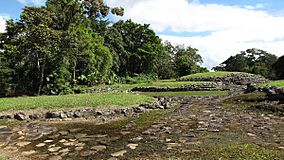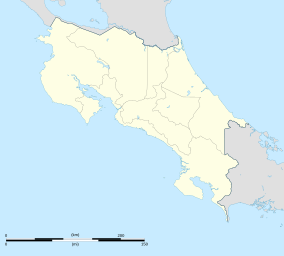Guayabo National Monument facts for kids
Quick facts for kids Guayabo National Monument |
|
|---|---|
|
IUCN Category III (Natural Monument)
|
|

Archaeological site within Guayabo
|
|
| Location | Costa Rica |
| Nearest city | Turrialba, Cartago |
| Area | 2.3 square kilometres (0.89 sq mi) |
| Established | 13 August 1973 |
| Governing body | National System of Conservation Areas (SINAC) |
The Guayabo National Monument (also known as Monumento Nacional Guayabo in Spanish) is an amazing ancient site in Costa Rica. It is located near the city of Turrialba, in the Cartago Province. This special place sits on the southern side of the Turrialba Volcano, almost in the middle of the country.
The monument covers about 2.3 square kilometres (0.89 sq mi) of land. It is surrounded by lush rainforest, which makes it look very green. This is because of lots of rain and rich soil. Only a small part of this ancient city has been dug up and studied by scientists.
Contents
The Ancient City of Guayabo
Guayabo de Turrialba was once a very important city. People started living here around 1000 BCE (that's 1000 years before Christ). They left the city around 1400 CE, which was about 100 years before the Spanish arrived in Costa Rica. No one knows exactly why they left. Researchers are still trying to figure it out! Some think it might have been because of a disease or attacks from other groups.
Scientists believe that about 10,000 people once lived in Guayabo. This ancient site was first found in the 1800s. The first big dig happened in 1882.
What Was Found at Guayabo?
Archaeologists, who are like history detectives, found many interesting things. They discovered the city's old roads, buildings, and water systems. They also found special stone carvings called petroglyphs, old tombs, and many artifacts. These discoveries were made during more digs in the 1960s.
The main part of the city that we know about has:
- 43 stone foundations where buildings once stood
- Three aqueducts, which are like ancient water pipes
- Two main roads and many smaller paths
- Some stone tombs
The people of Guayabo were very good engineers. Their aqueducts show how smart they were about moving water. Most of the site has circular mounds. These mounds were the bases for round wooden houses with thatched roofs. Families often lived together in these big houses.
Mound 1 and City Design
One special mound, called Mound 1, is the biggest one at the site. It is right in the center of the village. A paved road runs from this mound, connecting Guayabo to other settlements up to 9 kilometers away. This road is one of the most impressive discoveries!
The main building on Mound 1 was probably a symbol of power. It was also a place where important public meetings happened. If you went up the stairs next to the central mound, you would have seen two rectangular buildings. These were likely guardhouses. They controlled who could enter the settlement.
Artifacts and Daily Life
Many artifacts found at Guayabo show animals like jaguars and lizards. These were carved into stones and petroglyphs. Tools found here suggest that the people of Guayabo grew their own food. They mainly grew root vegetables like yucca. Most of the work was done by the villagers themselves.
Exploring Guayabo Today
After a cemetery was dug up in 1891, over 100 artifacts from Guayabo were shown around the world. They were displayed in Madrid in 1892 and then in Chicago in 1893. Famous explorers like Anastacio Alfaro and Carlos Aguilar helped dig up this site.
Today, scientists use new tools like remote sensing to study Guayabo. This helps them map the old roads in the area. In 2009, Guayabo was named an "International Historic Civil Engineering Landmark." This was because its roads, walls, and water channels show amazing engineering skills from an ancient civilization.
Visiting the Site
Guayabo National Monument is open to visitors every day. It has been a tourist attraction since August 13, 1973. You can hike on the trails and see the ancient structures. You can also take a tour with a professional guide.
Many people visit Guayabo because it is a bit of a mystery. Like other famous ancient sites such as Machu Picchu or Chichen Itza, Guayabo has amazing old buildings and artifacts. But the big question of why its people left makes it extra special. Also, a large part of the city is still hidden and not yet dug up. Its remote location in the rainforest also makes it a unique place to visit.
Preserving Guayabo
The ancient structures at Guayabo are in good condition today. Everything has been carefully kept as it was long ago. The site is protected as part of the Guayabo National Monument. It is also part of the Central Volcanic Conservation Area.
Keeping this site clean and real is very important to the people of Costa Rica. They value the environment and want to protect their history. Costa Rica is known for being one of the most environmentally friendly countries. Guayabo also gets fewer visitors than places like Machu Picchu, which makes it easier to keep well-preserved. Steps are being taken to make sure Guayabo stays in great shape for many years to come.
Gallery
See also
 In Spanish: Monumento nacional Guayabo para niños
In Spanish: Monumento nacional Guayabo para niños








